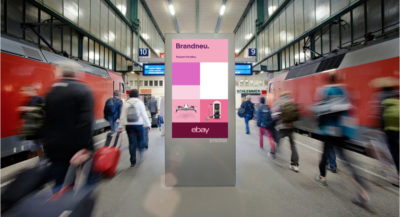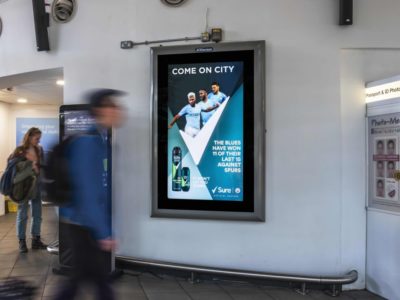
Poorly designed DOOH is an abomination, down to the last pink letter on a purple background. Over the years we’ve seen our share of ugly, disturbing, offensive and downright shameful DOOH. Design faux pas happens to the best of us. So, to avoid joining the worst of them let’s take a look at 7 design principles to live by while trying to target that on-the-go in an awesome kind of way.
One: know your software
With almost every brand jumping on board with DOOH marketing, you should announce a worldwide search for the best digital signage software ASAP. Kitcast TV – our DS soft partner – doesn’t ever fail to meet our expectations of a great soft, we’ve found them at the beginning of last year and they are yet to disappoint. Now we know for a fact that a huge chunk of DOOH design success relies on the ability to find the right digital signage software. Uninteresting and unattractive design is one of the main reasons companies switch DS soft provider. If your software checks all of your key features but has a subpar design, you need to keep on looking. You can have all of the bells and whistles packed into your perfectly functioning DS app, but if your DS software provider has failed to deliver on the design part, not even beacons, IOT, Web triggers or any other features will help you effectively market your product. Prior to your brand ever having the ability to effortlessly create beautiful engaging signage your DS soft provider has to spend a lot of time and money on modern, sleek, eye-catching designs. So, choose a DS soft company, go through their client list and check out digital signage that other brands have created. And if you want to check out our awesome DS partner you can check out their designs at https://kitcast.tv.
Two: do your research

There are a lot of key steps that must be taken in order to ensure a rock-solid design and great user experience, though doing your research is always at the top of that list. I really want to highlight the importance of knowing the industry norms. Clearly understanding and assessing what your brand’s competitors are doing is of the highest importance. Look through their DOOH campaigns; check what’s working for them, what designs are bringing the maximum results, what are the main problems and where do they fall short.
Three: don’t use creativity for the sake of using creativity
If I’ve seen it once, I’ve seen it a thousand times: some DOOH is way too creative for their own good. Creativity in advertising is a great idea (more often than not), though at times I found myself wondering “what was the product?” or “what’s the brand?”. So, the absolute design bare minimum for any given DOOH ad should be: if you expect a tidal wave of new customers the customers should clearly know who you are. The perfect digital communication design should always reflect the brand style, incorporate colors, fonts, logo, etc. This principle is applicable to any form of advertisement. Just so you know: the yearly over-the-top creative 4$ million a spot Super Bowl TV ads with a 100 million watching often show worse results than regular ads, and the research always shows that the main problem is that brands going down right crazy with creativity.
Four: use the KISS (keep it simple, stupid) design principle
Ever wonder how many ads your customers see a day? A hundred? Two hundred? A thousand? Well, your challenge is to stand out in the sea of around 4 to 10 thousand ads per day. That is the number of ads a regular consumer is exposed to every day. So, clean design, clear message and attention-grabbing abilities of the digital out-of-home will give you a good fighting chance. To make a bigger impact and engage more people always try to keep your design simple. Display a message that pops, don’t overcomplicate your design with buzzy background, unreadable fonts, unclear messaging, etc. In short: when you think the design is perfect, leave it for a day than re-evaluate and, if necessary, re-simplify.
Five: learn to design specifically for DOOH

Since DOOH has become an integrated part of our daily lives, the “attention-grabbing content” has become the main battleground and design – our weapon of choice. Obviously, those that have done their homework and mastered the DOOH-specific approach for their design will be able to avoid mediocre results. The good news is: most of the impactful design rules we used to create eye-catching and effective OOH are easily applicable to DOOH. It all starts with transforming a great story into visually pleasing easy to remember content. You have to be creative, loud, succinct, you can’t use more than six words, use contrasting colors, be interesting, and never ignore the “don’t say it, show it” approach, etc. All of it still applies, but, understanding how to cleverly integrate digital will make your design truly DOOH specific and bring it to the new level.
DOOH specific design should be based on the understanding of the integrative cutting edge tech. Video, interactive content, beacons, mobile tech integration, any kind of sensors, live content stream – all of the above should be a huge part of the process while creating and designing your digital signage.
Six: test and analyze for a better design
Learn how to use DOOH analytics and identify what’s important. Nowadays the effectiveness of the DOOH design can be assessed based on the data. This means that you can test out all of your designs and ultimately polish them to the point of perfection. DOOH is now easily integrated with a lot of other techsthat can help us understand who responds to designs, when this or that ad design has maximum viewability, how much time people are spending in front of your screen, etc.
Seven: become your own observer
This one is easy: to create a great user experience you are going to have to become a user. You need to know if your design and the screen size work together, test out the viewing distance when creating your DOOH design, use a great easy-to-read font, and check if the font size is viewable from afar. Just go and stand where your customers will be standing and you will know exactly how they will be experiencing your DOOH. By clearly understanding your audience’s experience, you’ll automatically be able to make it a top priority. The principal of keeping the customers experience top of mind is a sure way to produce a successful DOOH design.


